The Non-Barrier Bag Market is estimated to be valued at USD 14.3 billion in 2025 and is projected to reach USD 20.6 billion by 2035, registering a compound annual growth rate (CAGR) of 3.7% over the forecast period.
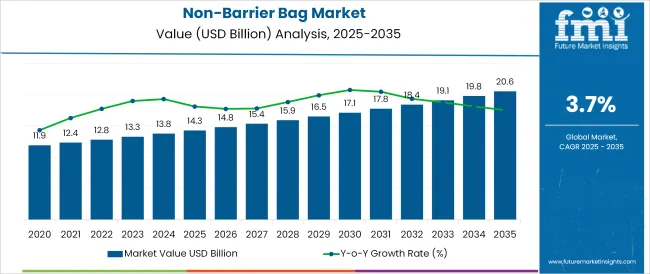
The non-barrier bag market is experiencing steady expansion, driven by widespread demand for flexible packaging solutions that balance affordability, functionality, and sustainability. These bags, which do not rely on oxygen or moisture barrier layers, are increasingly adopted for short-shelf-life products and internal supply chain usage where extensive barrier protection is not essential.
Growth is further influenced by the rapid rise in retail, foodservice, and industrial sectors seeking low-cost packaging options that meet recyclability and source-reduction goals. Advances in printing technologies and resin formulation have improved customization, printability, and mechanical strength, supporting broader product adoption.
The market is also benefiting from increased emphasis on mono-material packaging formats and integration into circular economy strategies. Looking ahead, demand is expected to grow across emerging economies, supported by urbanization, evolving retail infrastructure, and changing consumer preferences for flexible, user-friendly packaging formats.
The market is segmented by Material Type and Application and region. By Material Type, the market is divided into Polyethylene (PE), Aluminum Foil, Paper, and Others. In terms of Application, the market is classified into Food & Beverages, Personal Care, Electrical & Electronics, and Others. Regionally, the market is classified into North America, Latin America, Western Europe, Eastern Europe, Balkan & Baltic Countries, Russia & Belarus, Central Asia, East Asia, South Asia & Pacific, and the Middle East & Africa.
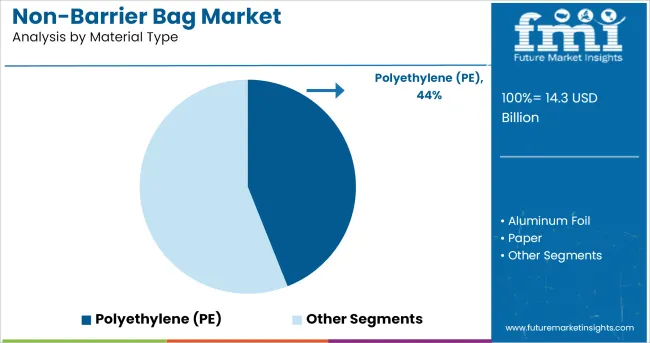
Polyethylene (PE) is expected to account for 44.0% of the total revenue share in the non-barrier bag market in 2025, making it the dominant material type. This segment’s leadership is being driven by PE’s versatility, processability, and favorable cost-to-performance ratio in flexible packaging. The material’s ease of extrusion, sealing, and printing has enabled high-speed manufacturing and adaptability across a wide range of packaging formats.
Additionally, PE’s compatibility with recycling systems and growing use in mono-material structures align with global sustainability and compliance mandates. Lightweight yet durable, PE non-barrier bags offer resistance to tearing and punctures, making them ideal for food, retail, and industrial applications that do not require advanced protection.
Innovations in PE resin grades, including low-density and linear low-density polyethylene (LDPE and LLDPE), have further strengthened its position by offering varying levels of stiffness, clarity, and flexibility. The material’s established supply chain and recyclability infrastructure continue to reinforce its preference across packaging converters and brand owners alike.
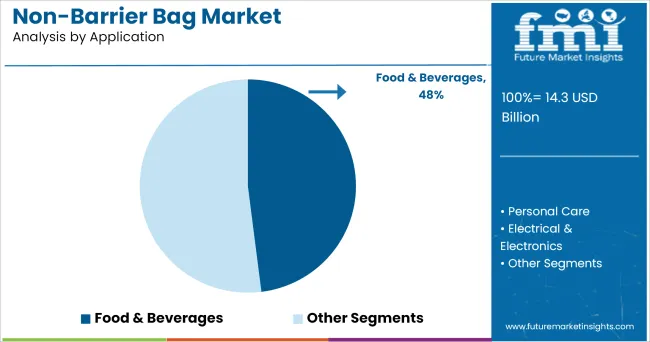
The food & beverages application segment is projected to lead the non-barrier bag market with a 48.0% revenue share in 2025. This segment’s dominance is being shaped by the sector’s reliance on lightweight, disposable, and cost-efficient packaging formats for dry, semi-moist, and short-shelf-life products. Non-barrier bags are widely used in secondary packaging, portion packs, and quick-service operations where long-term preservation is not a priority.
Their suitability for direct and indirect food contact, combined with customizable printing for branding and regulatory labeling, supports their widespread use in bakery items, fresh produce, snacks, and powdered ingredients. Additionally, the shift toward sustainable packaging formats has prompted food producers to adopt recyclable and single-material options such as PE-based non-barrier bags.
Regulatory changes and consumer demand for reduced plastic waste have further encouraged adoption of simpler, source-reduced packaging formats. As supply chain efficiency, cost control, and environmental impact remain top priorities, food and beverage companies are expected to continue driving growth in this segment.
There is an increase in demand to introduce versatility in bags, which is getting adopted by packaging manufacturers. Thus, these manufacturers are introducing non-barrier bags, serve convenience of consumers. There is also an increase in demand of non-barrier bags in commercial and domestic settings, which is a major factor fueling growth of its market.
Stopping the movement of gases, water vapour, smell, and even light, these features of non-barrier bags are further driving the growth and also reduce global food waste.
As non-barrier bags are made from many kind of different materials, which help to find out the oxygen transmission rate. Due to three layers of these bags: inner, outer and middle layers, mechanical or barrier efficiency are increased.
Market players of non-barrier bags are focusing on offering high performance and cost-effective barrier bags, which is further driving the market globally. Rapid industrialization and growing cross border trades across the world is also contributing to the growth of non-barrier bags.
Companies are continuously striving to create sustainable products and solutions as there is a rise in demand of non-barrier bags. This is also encouraging them to develop more sustainable bags for solid, liquids and semi liquid packs. For an instance in 2020, a company named Vishakha introduced first ever recyclable barrier film in India for liquid packaging at Plast India 2020, such initiatives will further drive the growth of non-barrier bags.
The rise in growing consumer dissatisfaction toward damaged and mangled electronic products is also driving the growth of non-barrier bags. Seafood application are using 10KOTR film that meets FDA permeability guidelines, which is also one of the factor helping the market to grow.
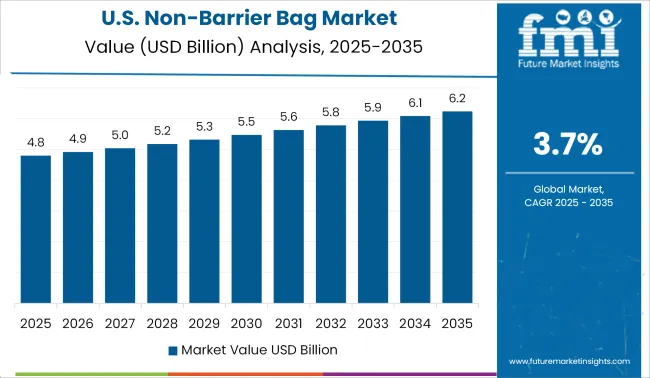
The demand for non-barrier bags is anticipated to grow at a significant rate in North America owing to continuous innovation in flexible packaging solutions. In addition, United States has majority of the key vendors of non-barrier bag solutions. This is one of the major factor driving the growth of the market.
All the major companies in the region are moving towards the development of non-barrier bags as it will also reduce global food waste. Industries of this region have shown a keen interest in investing in non-barrier bags market. The growing demand for flexible packaging solutions in North America has opened new growth avenues for non-barrier bags solution.
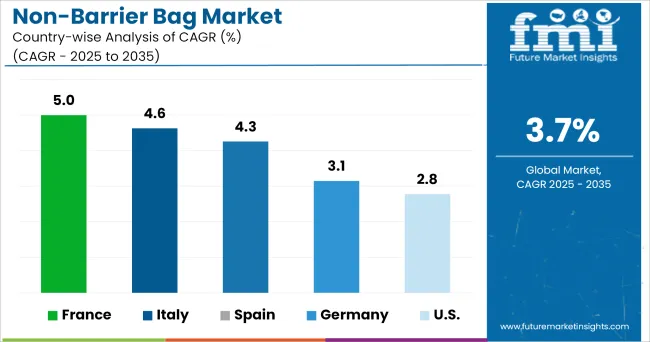
Currently, Europe region is one of the biggest market in non-barrier bags consumption. Many key players in the region are aiming for collaboration, acquisition and new product strategies to escalate their business presence. The growing demand for high performance and cost-effective barrier bags through non-barrier bags solution has opened new growth avenues for its market in the region.
Non-barrier bags solutions has moved far beyond in Europe and this leads the way for growth of its market globally.
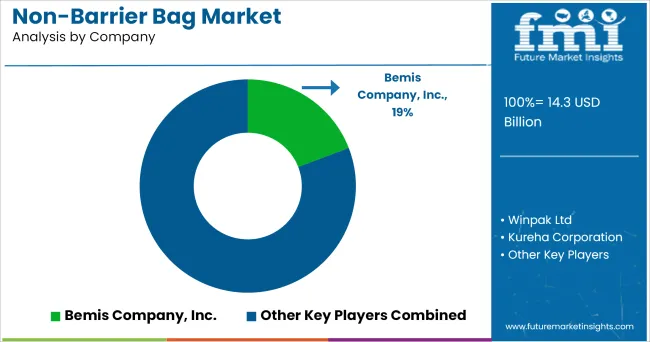
Some of the leading vendors of non-barrier bags include
These vendors are adopting various key strategies, to increase their customer base locally and globally. They are also spending millions of dollars into product R&D to fulfil the unmet needs of their customers for non-barrier bags.
The report is a compilation of first-hand information, qualitative and quantitative assessment by industry analysts, inputs from industry experts and industry participants across the value chain. The report provides in-depth analysis of parent market trends, macro-economic indicators and governing factors along with market attractiveness as per segments. The report also maps the qualitative impact of various market factors on market segments and geographies.
The global non-barrier bag market is estimated to be valued at USD 14.3 billion in 2025.
The market size for the non-barrier bag market is projected to reach USD 20.6 billion by 2035.
The non-barrier bag market is expected to grow at a 3.7% CAGR between 2025 and 2035.
The key product types in non-barrier bag market are polyethylene (pe), aluminum foil, paper and others.
In terms of application, food & beverages segment to command 48.0% share in the non-barrier bag market in 2025.






Our Research Products

The "Full Research Suite" delivers actionable market intel, deep dives on markets or technologies, so clients act faster, cut risk, and unlock growth.

The Leaderboard benchmarks and ranks top vendors, classifying them as Established Leaders, Leading Challengers, or Disruptors & Challengers.

Locates where complements amplify value and substitutes erode it, forecasting net impact by horizon

We deliver granular, decision-grade intel: market sizing, 5-year forecasts, pricing, adoption, usage, revenue, and operational KPIs—plus competitor tracking, regulation, and value chains—across 60 countries broadly.

Spot the shifts before they hit your P&L. We track inflection points, adoption curves, pricing moves, and ecosystem plays to show where demand is heading, why it is changing, and what to do next across high-growth markets and disruptive tech

Real-time reads of user behavior. We track shifting priorities, perceptions of today’s and next-gen services, and provider experience, then pace how fast tech moves from trial to adoption, blending buyer, consumer, and channel inputs with social signals (#WhySwitch, #UX).

Partner with our analyst team to build a custom report designed around your business priorities. From analysing market trends to assessing competitors or crafting bespoke datasets, we tailor insights to your needs.
Supplier Intelligence
Discovery & Profiling
Capacity & Footprint
Performance & Risk
Compliance & Governance
Commercial Readiness
Who Supplies Whom
Scorecards & Shortlists
Playbooks & Docs
Category Intelligence
Definition & Scope
Demand & Use Cases
Cost Drivers
Market Structure
Supply Chain Map
Trade & Policy
Operating Norms
Deliverables
Buyer Intelligence
Account Basics
Spend & Scope
Procurement Model
Vendor Requirements
Terms & Policies
Entry Strategy
Pain Points & Triggers
Outputs
Pricing Analysis
Benchmarks
Trends
Should-Cost
Indexation
Landed Cost
Commercial Terms
Deliverables
Brand Analysis
Positioning & Value Prop
Share & Presence
Customer Evidence
Go-to-Market
Digital & Reputation
Compliance & Trust
KPIs & Gaps
Outputs
Full Research Suite comprises of:
Market outlook & trends analysis
Interviews & case studies
Strategic recommendations
Vendor profiles & capabilities analysis
5-year forecasts
8 regions and 60+ country-level data splits
Market segment data splits
12 months of continuous data updates
DELIVERED AS:
PDF EXCEL ONLINE
Market Share Distribution Among Non-Barrier Bag Providers
Bag Feed Seal Pouch Packaging Machine Market Size and Share Forecast Outlook 2025 to 2035
Bag in Tube Market Size and Share Forecast Outlook 2025 to 2035
Bagasse Tableware Products Market Size and Share Forecast Outlook 2025 to 2035
Bag Closure Clips Market Size and Share Forecast Outlook 2025 to 2035
Bag-in-box Packaging Market Size and Share Forecast Outlook 2025 to 2035
Bag Making Machine Market Size and Share Forecast Outlook 2025 to 2035
Bag Closures Market Size and Share Forecast Outlook 2025 to 2035
Bag On Valve Product Market Size and Share Forecast Outlook 2025 to 2035
Bagging Equipment Market Size and Share Forecast Outlook 2025 to 2035
Bag Sealer Market Analysis - Size and Share Forecast Outlook 2025 to 2035
Bagging Machine Market Size and Share Forecast Outlook 2025 to 2035
Bag-in-Bottle Market Size and Share Forecast Outlook 2025 to 2035
Bagasse Disposable Cutlery Market Size and Share Forecast Outlook 2025 to 2035
Bagasse Bowls Market Size and Share Forecast Outlook 2025 to 2035
Bag-in-Box Filler Market Insights - Growth & Forecast 2025 to 2035
Bag Market Insights - Growth & Demand 2025 to 2035
Bag Clips Market Insights – Demand, Trends & Forecast 2025 to 2035
Baggage Scanner Market Growth, Trends & Forecast 2025 to 2035
Bag Re-sealer Market Growth – Size, Trends & Forecast 2025 to 2035

Thank you!
You will receive an email from our Business Development Manager. Please be sure to check your SPAM/JUNK folder too.
Chat With
MaRIA